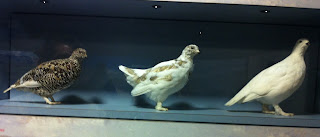Birds build their nests in a tree right? Well I found this bird nest very high on the side of a building at CVS! Why do you think the small sparrow chose this spot instead of a tree? I feel sorry for the baby bird that has to learn how to fly out of this nest,. (No soft soil to soften the fall) Did you know that so many birds choose signs like this one to build their nest in, that sign companies have began putting spikes in their signs to discourage birds from building, Poor birds, we cut down their trees to build stores and houses and now take away their signs! As you are out this summer, see if you see nests in unusual places.
When I was young my mom and I would put pieces of colored yarn out for the birds. We enjoyed seeing the birds sometimes take the yarn and fly away. Occasionally we would see our yarn in a nest nearby. Most birds build nest in the early spring.
Birds are quite ingenious in building their nests.What they use to build depends on where they live. They will use anything available. such as twigs, plastic, paper, string, shells, rocks, and leaves.
They use their beak to transfer all the materials to the nest, perhaps making hundreds of trips, They then use their beak to weave the materials together and sometimes use mud, saliva and even spider webs to stick it together, They are quite the builder.
Most birds do not actually live in the nest but it does provide a safe shelter for the eggs and babies until they are ready to leave. You may have seen a mother bird guarding her nest from a nearby tree.
She will get very vocal and may swoop down in an attempt to scare you away.
Fun Activity
Perhaps you would like to get a sense of what it feels like to build a nest. Collect things around your house such as string, plant pieces, pieces of plastic, twigs etc. Try to weave them together and use clay, playdoh or even mud to stick it all together. Imagine a bird with only his beak doing this!
Here is a website if you would like to learn more about the wonder of birds!
http://www.audubonmagazine.org/features0803/truenature-webexclusives.html
Good time to read my favorite book too!
Are You My Mother? by P.D..Eastman
Don't have it? Go to the Library and check it out! There is lots of great bird books there too!
Observe your world! Read about your world ! Get smarter!


















































